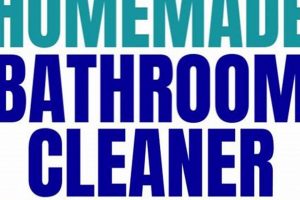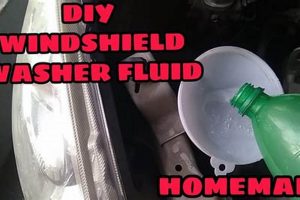A homemade alternative to commercially manufactured cleaning agents used for washing kitchenware is formulated from readily available ingredients. Recipes often incorporate substances such as washing soda, borax, liquid castile soap, and essential oils. These components are combined to create a solution intended to remove food particles and grease from dishes and utensils.
This approach to creating a household cleaner offers several advantages, including the potential for cost savings, the ability to control the ingredients used, and a reduction in exposure to potentially harsh chemicals found in some commercial products. Historically, the practice of crafting cleaning solutions from natural sources predates the widespread availability of mass-produced detergents, reflecting a return to simpler, more sustainable methods.
The subsequent sections will delve into specific formulations, safety considerations, environmental impacts, and comparisons with commercially available options. This exploration aims to provide a comprehensive understanding of the viability and effectiveness of creating washing solutions at home.
Formulating Effective Cleaning Solutions at Home
The following outlines best practices for the creation and utilization of cleaning agents made from scratch. Adherence to these guidelines promotes both efficacy and safety.
Tip 1: Ingredient Selection. Washing soda (sodium carbonate) is crucial for cutting grease. Borax (sodium borate) acts as a cleaning booster and disinfectant. Liquid castile soap provides the sudsing action. Ensure all components are compatible and sourced from reputable suppliers to maintain product integrity.
Tip 2: Precise Measurement. Accurate ratios of ingredients are vital for optimal cleaning performance. Deviations can result in ineffective cleaning or potential residue buildup on dishware. Use measuring cups and spoons for consistency.
Tip 3: Thorough Mixing. Proper emulsification of components is critical. If the solution separates, its efficacy is diminished. Use a whisk or immersion blender to achieve a uniform consistency, especially when incorporating essential oils.
Tip 4: Water Quality Considerations. Hard water can inhibit the effectiveness of homemade cleaners. If hard water is present, consider using distilled water or adding a water softening agent such as borax in slightly increased quantities.
Tip 5: Storage Practices. Store the final product in a clean, airtight container to prevent contamination and evaporation. Clearly label the container with the contents and date of production to avoid confusion.
Tip 6: Residue Management. Due to the natural ingredients, there might be a slight residue compared to commercial detergents. Ensure dishes are rinsed thoroughly under hot water to eliminate any lingering film.
Tip 7: Essential Oil Integration. When incorporating essential oils for fragrance and antimicrobial properties, select oils known for their cleaning capabilities, such as lemon, tea tree, or lavender. Use sparingly, as excessive amounts can create an overpowering scent.
Implementing these guidelines enhances the effectiveness and safety of homemade cleaning solutions, offering a cost-effective and environmentally conscious alternative to commercially manufactured options.
The subsequent sections will address potential challenges, alternative recipes, and long-term sustainability considerations of home-prepared cleaning agents.
1. Cost Effectiveness
The formulation of washing solutions at home offers a direct pathway to potential cost reduction compared to purchasing commercially manufactured detergents. The primary cost savings stem from the utilization of basic ingredients, often acquired in bulk at lower per-unit prices than pre-mixed products. For example, a large container of washing soda or liquid castile soap can yield multiple batches of cleaning solution, significantly reducing the long-term expense associated with frequent repurchases of store-bought options. Furthermore, minimizing packaging costs contributes to overall savings.
Real-world examples demonstrate the practical significance of this cost-effective approach. A household consuming a standard bottle of commercial detergent every month could potentially reduce its annual expenditure by a substantial margin through the adoption of home-prepared alternatives. This is particularly relevant for larger families or individuals with heightened cleaning needs. Moreover, the option to tailor the formula to specific requirements allows for precise control over ingredient quantities, further optimizing resource allocation and minimizing waste.
In conclusion, the economic benefits associated with crafting washing solutions at home are readily apparent. While initial investment in base ingredients may be required, the long-term cost savings, coupled with the flexibility to customize formulations and reduce waste, render this approach a viable and potentially more economical alternative to reliance on commercially available products. The realization of these savings, however, is contingent upon diligent ingredient sourcing and precise formulation practices.
2. Ingredient Control
The ability to exert complete influence over the components within a washing solution is a central tenet of home preparation. This contrasts sharply with commercially available products, where ingredient lists can be obfuscated or include substances of questionable safety or environmental impact. Ingredient control directly impacts user health and environmental sustainability by allowing for the exclusion of known allergens, irritants, or persistent pollutants. The selection of natural, biodegradable alternatives becomes a deliberate act rather than a passive acceptance of commercially formulated ingredients.
Consider the case of individuals with sensitivities to synthetic fragrances or dyes, common additives in commercial detergents. By formulating a cleaning agent at home, these substances can be entirely omitted, mitigating potential allergic reactions or skin irritations. Similarly, concerns regarding the presence of phosphates, known contributors to water pollution, can be addressed by selecting phosphate-free alternatives readily available for home mixing. The intentional selection of each component, from the base soap to the optional essential oils, creates a level of transparency and customization unattainable with mass-produced items. This control extends to adjusting concentrations of individual ingredients based on specific needs, such as increasing the degreasing power for heavily soiled cookware.
In summary, ingredient control is not merely a superficial benefit but a fundamental advantage of crafting cleaning solutions at home. It empowers individuals to prioritize their health, minimize environmental impact, and tailor the cleaning agent to their unique requirements. The practice neces
sitates informed decision-making regarding the properties and potential effects of each ingredient, ensuring a responsible and sustainable approach to household cleaning. The effectiveness of exercising ingredient control hinges upon the user’s knowledge and diligence in selecting appropriate and safe components.
3. Environmental Impact
The creation of washing solutions at home offers opportunities to mitigate the environmental consequences associated with commercially manufactured detergents. The following facets highlight key areas where home preparation can contribute to a more sustainable approach.
- Biodegradability of Ingredients
Commercial detergents often contain synthetic surfactants and other compounds that persist in the environment, leading to water pollution and potential harm to aquatic ecosystems. The use of readily biodegradable ingredients, such as plant-based soaps and natural cleaning agents, in homemade solutions reduces the environmental burden by facilitating quicker decomposition and minimizing the accumulation of harmful substances in waterways. Examples include the use of castile soap derived from vegetable oils and the avoidance of petroleum-based surfactants.
- Reduction in Plastic Packaging
Commercially available detergents are typically packaged in plastic containers, contributing to plastic waste accumulation. Preparing washing solutions at home allows for the use of reusable glass or metal containers, significantly reducing the demand for single-use plastics. This practice addresses the issue of plastic pollution by minimizing the generation of new plastic waste and promoting a circular economy.
- Lower Energy Consumption in Production and Transportation
The manufacturing and transportation of commercial detergents involve significant energy consumption, contributing to greenhouse gas emissions. By preparing washing solutions at home, individuals can reduce their indirect energy footprint by eliminating the need for industrial production processes and long-distance transportation. The localized nature of home preparation minimizes energy expenditure and promotes a more decentralized, sustainable model.
- Elimination of Harmful Chemicals
Commercial detergents may contain phosphates, chlorine bleach, and other chemicals known to have adverse environmental effects. Phosphates contribute to eutrophication in waterways, while chlorine bleach can generate harmful byproducts. Formulating washing solutions at home allows for the avoidance of these chemicals, reducing the risk of environmental contamination and promoting safer cleaning practices. Alternatives such as borax and washing soda offer effective cleaning power without the detrimental environmental consequences.
The multifaceted benefits of home-prepared washing solutions underscore their potential to minimize environmental harm compared to commercially available counterparts. By prioritizing biodegradable ingredients, reducing plastic waste, lowering energy consumption, and eliminating harmful chemicals, individuals can adopt a more sustainable approach to household cleaning. However, the actual environmental impact depends on responsible sourcing, proper disposal, and informed choices regarding ingredient selection.
4. Formula Customization
The capacity to modify recipes directly correlates with the practicality and effectiveness of home-prepared washing solutions. This adaptability enables individuals to tailor the cleaning agent to specific needs, addressing variations in water hardness, soil type, and personal sensitivities. The effect of customization is a product that optimally performs under given conditions, maximizing cleaning power while minimizing potential adverse reactions. The importance of formula modification resides in its ability to transform a general recipe into a targeted solution.
A practical illustration arises in regions with hard water, where the mineral content interferes with the sudsing action of conventional soaps. By increasing the concentration of water softeners, such as borax or washing soda, the cleaning performance can be significantly enhanced. Individuals with sensitive skin can formulate hypoallergenic solutions by excluding essential oils or fragrances known to cause irritation. Furthermore, the cleaning strength can be adjusted based on the typical level of soiling, resulting in a solution that is neither excessively harsh nor ineffectively mild. The tailoring allows for optimized washing solution performance and prevents waste from excessive usage and ineffective cleaning.
In summary, the ability to customize homemade washing solutions is a fundamental advantage, facilitating adaptation to diverse circumstances and individual requirements. The challenges associated with customization involve understanding the properties of various ingredients and their interactions, requiring a degree of knowledge and experimentation. However, the resulting benefits optimized cleaning performance, reduced allergenic potential, and minimized environmental impact render formula modification a crucial aspect of home preparation.
5. Skin Sensitivity
Skin sensitivity is a significant factor when considering cleaning solutions, especially those intended for direct contact with hands during dishwashing. Home-prepared alternatives offer the potential to mitigate adverse reactions often associated with commercially manufactured detergents.
- Irritant Reduction
Commercial detergents frequently contain synthetic fragrances, dyes, and preservatives that can trigger allergic contact dermatitis or irritant contact dermatitis in susceptible individuals. Home formulations allow for the elimination of these known irritants, minimizing the risk of adverse skin reactions. For example, individuals sensitive to methylisothiazolinone (MIT), a common preservative, can avoid this ingredient entirely in a homemade solution.
- pH Control
The pH of a cleaning agent significantly affects its potential to cause skin irritation. Highly alkaline solutions can disrupt the skin’s natural barrier function, leading to dryness, redness, and itching. Homemade recipes offer the opportunity to adjust the pH through the selection of milder ingredients or the addition of buffering agents, resulting in a solution that is less likely to cause irritation. For instance, opting for a castile soap with a lower pH than a typical dish detergent can contribute to a gentler formula.
- Hydrating Additives
Many individuals experience dry or cracked skin from frequent dishwashing. Home formulations can incorporate moisturizing ingredients, such as glycerin or aloe vera, to counteract the drying effects of cleaning agents. These additives help to maintain the skin’s hydration level, reducing the likelihood of irritation and promoting overall skin health. The inclusion of such emollients is often absent in commercial detergents, which prioritize degreasing power over skin conditioning.
- Concentration Management
The concentration of surfactants in cleaning solutions can b
e a major determinant of their irritancy potential. Homemade recipes enable precise control over the concentration of active cleaning ingredients, allowing for the creation of a diluted solution that is effective yet gentle on the skin. In contrast, commercial detergents often employ high concentrations of surfactants to maximize cleaning performance, potentially leading to increased skin irritation. Adjusting the amount of soap used in a homemade formula can tailor the cleaning power to the task at hand while minimizing skin exposure to harsh chemicals.
These facets of skin sensitivity highlight the potential benefits of home-prepared washing solutions for individuals prone to skin irritation or dryness. The ability to control ingredients, adjust pH levels, incorporate hydrating additives, and manage surfactant concentrations offers a pathway to a more gentle and skin-friendly dishwashing experience. The successful implementation of these strategies requires careful consideration of ingredient properties and individual sensitivities.
6. Cleaning Efficacy
The primary function of any washing solution is to effectively remove food particles, grease, and other contaminants from dishware, thereby ensuring hygienic standards. The cleaning efficacy of a homemade dish soap is directly related to its formulation, specifically the type and concentration of cleaning agents employed. The effectiveness of ingredients such as washing soda for grease cutting, borax as a cleaning booster, and castile soap for emulsification determines the resultant cleaning power. Inadequate ratios or the selection of inappropriate ingredients can compromise the ability of the washing solution to effectively sanitize dishware, potentially leading to the persistence of bacteria and foodborne illnesses. For example, a solution lacking sufficient alkalinity may fail to adequately dissolve hardened grease, leaving a residue on the cleaned surfaces.
The assessment of cleaning efficacy requires consideration of various factors, including water temperature, soaking time, and the nature of the soil being removed. Higher water temperatures generally enhance the effectiveness of washing solutions by increasing the solubility of fats and oils. Soaking heavily soiled items prior to washing allows the cleaning agents to penetrate and loosen stubborn residues. Furthermore, the specific type of soil whether it be protein-based, carbohydrate-based, or fat-based influences the choice of cleaning agents and the required concentration. For instance, a solution formulated for removing greasy residues may prove less effective against dried-on starches. Practical applications include adjusting the amount of washing soda for dishes with baked-on food or pre-soaking items in a solution of borax and hot water to loosen stubborn stains.
In summary, the cleaning efficacy of washing solutions made at home is a critical determinant of their viability as a substitute for commercially manufactured detergents. While ingredient control, cost effectiveness, and environmental considerations are important, the fundamental requirement remains the ability to effectively clean and sanitize dishware. Maintaining an adequate level of cleaning efficacy necessitates careful formulation, appropriate usage techniques, and a thorough understanding of the properties of the ingredients employed. Challenges include achieving consistent results across varying water conditions and soil types, necessitating ongoing refinement of recipes and techniques.
Frequently Asked Questions About Washing Solutions Made At Home
The following addresses common inquiries and clarifies misconceptions surrounding the creation and use of cleaning agents formulated from basic ingredients. These responses aim to provide a factual and objective understanding of the practice.
Question 1: Are homemade washing solutions as effective as commercial detergents?
The efficacy of cleaning solutions created at home is contingent upon proper formulation and usage. When using appropriate ingredients in correct ratios, a washing solution made from scratch can achieve comparable cleaning results to many commercial detergents. However, factors such as water hardness and soil type can impact performance, requiring adjustments to the recipe or technique. Rigorous testing and assessment are necessary to validate the effectiveness of any particular formulation.
Question 2: What are the potential risks associated with using homemade cleaning agents?
Potential risks include skin irritation from certain ingredients, such as essential oils or high concentrations of alkali substances. Incomplete mixing can also lead to uneven distribution of ingredients, resulting in inconsistent cleaning and potential residue buildup. Furthermore, improper storage may cause contamination or degradation of the solution. It is imperative to follow established recipes and handle ingredients with caution, wearing gloves and eye protection as necessary.
Question 3: How does the cost of making washing solutions at home compare to buying commercial detergents?
The overall cost depends on ingredient selection and purchasing habits. Sourcing basic ingredients in bulk typically yields lower per-unit costs than buying pre-mixed detergents. However, specialized or organic ingredients may increase the expense. The long-term cost-effectiveness also depends on usage patterns and the frequency of repurchase for either homemade or commercial options. A thorough cost analysis should account for all relevant factors.
Question 4: Are homemade dish soaps environmentally friendly?
Homemade alternatives can be more environmentally sustainable than commercial detergents, provided that biodegradable ingredients are used and plastic packaging is minimized. The environmental impact is influenced by the sourcing of ingredients, the manufacturing processes involved, and the disposal methods employed. Selecting plant-based soaps and avoiding harmful chemicals reduces the environmental footprint. Responsible disposal practices further enhance sustainability.
Question 5: Can homemade washing solutions be used in dishwashers?
The suitability of home-prepared washing solutions for dishwashers varies depending on the formulation and the dishwasher model. Some ingredients, such as castile soap, can produce excessive suds, potentially damaging the appliance. It is essential to research the compatibility of the specific recipe with the dishwasher manufacturer’s recommendations. Testing in a small, inconspicuous area is advisable before widespread use.
Question 6: What is the shelf life of a homemade washing solution?
The shelf life depends on the ingredients used and the storage conditions. Solutions containing essential oils may degrade over time, losing their fragrance and potency. Exposure to air, light, or extreme temperatures can also affect the stability of the solution. Storing the mixture in a cool, dark place in an airtight container maximizes its longevity. A visual inspection for changes in color, odor, or consistency can indicate spoilage.
In essence, crafting washing solutions at home presents both opportunities and challenges. Informed decision-making, careful formulation, and responsible practices are essential for achieving effective cleaning and minimizing potential risks.
The following section delves into specific recipes and provides detailed instructions for creating effective washing solutions from scratch.
Conclusion
The preceding exploration has illuminate
d the multifaceted aspects of diy dish soap, from its potential cost savings and ingredient control to its environmental implications and cleaning efficacy. The ability to tailor formulations to individual needs and minimize exposure to harsh chemicals represents a significant advantage. However, the need for precise measurements, thorough mixing, and informed ingredient selection cannot be understated. The success of home-prepared solutions hinges upon a commitment to responsible practices and a willingness to adapt to varying conditions.
The decision to embrace diy dish soap ultimately rests on a careful evaluation of individual priorities and resources. While the potential benefits are considerable, a balanced approach that considers both the advantages and the challenges is paramount. Continued research and experimentation will undoubtedly refine existing methods and uncover new possibilities, paving the way for more sustainable and effective cleaning practices in the future.



![DIY Build: Circular Saw Crosscut Jig PDF Plans [Free] The DIY Hub: Creative Crafts, Repairs & Life Hacks DIY Build: Circular Saw Crosscut Jig PDF Plans [Free] | The DIY Hub: Creative Crafts, Repairs & Life Hacks](https://craftingdiycenter.com/wp-content/uploads/2025/07/th-5916-300x200.jpg)


![Diya Aur Baati Hum: Illuminate Your Home [DIY Guide] The DIY Hub: Creative Crafts, Repairs & Life Hacks Diya Aur Baati Hum: Illuminate Your Home [DIY Guide] | The DIY Hub: Creative Crafts, Repairs & Life Hacks](https://craftingdiycenter.com/wp-content/uploads/2025/07/th-5913-300x200.jpg)
